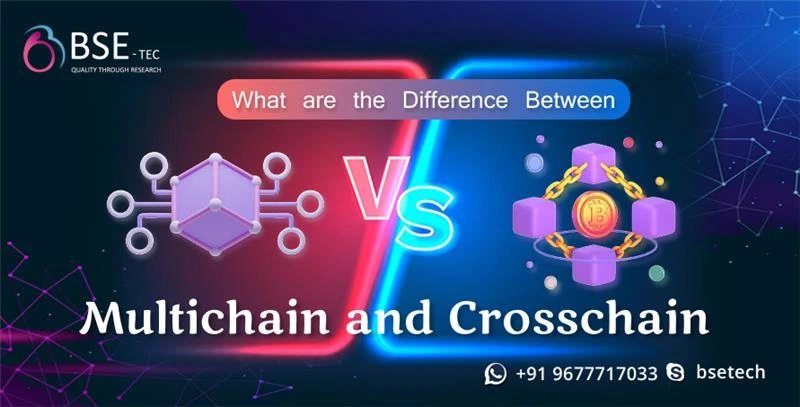What are the Difference Between Multichain and Crosschain

As blockchain technology continues to evolve, two frequently common terms are multichain and cross-chain. While they may sound similar, they refer to distinct concepts that play crucial roles in enhancing the blockchain ecosystem. Let’s explore their definitions, differences, and implications.
What is Multichain?
Multichain refers to an architecture where multiple independent blockchains operate simultaneously. Each blockchain in a multichain network can have its own rules, protocols, and governance. This setup allows for developing specialized chains tailored to specific use cases while leveraging the strengths of different blockchain technologies.
Key Features of Multichain
Independent Blockchains: Each chain functions independently, allowing for diverse applications and use cases.
Specialization: Different blockchains can be optimized for various functions, such as scalability, speed, or smart contract capabilities.
Scalability: By distributing transactions across multiple chains, multichain networks can process more transactions simultaneously.
What is Cross-chain?
Cross-chain technology enables interoperability between different blockchain networks. It allows the transfer of assets or data across separate chains, making it possible for users to interact with multiple blockchains seamlessly. Cross-chain solutions facilitate communication and transactions, ensuring that assets can move freely from one blockchain to another.
Key Features of Cross-chain
- Interoperability: Enables different blockchain networks to communicate and share data or assets.
- Asset Transfers: Users can transfer tokens or data across different blockchains without needing a centralized exchange.
- Composability: DApps (decentralized applications) can leverage the strengths of multiple chains, enhancing functionality and user experience.
| Features | Multichain | Crosschain |
| Definition | Multiple independent blockchains | Interoperability between different blockchains |
| Functionality | Specialized chains for specific uses | Enables asset and data transfers between chains |
| Independence | Chains operate independently | Requires collaboration for interaction |
| Examples | Polkadot, Cosmos | Wrapped tokens, bridges (e.g., ChainBridge) |
When to Choose Multi chain?
- Value: If the application requires distinct functionalities or features that are best served by dedicated blockchains (for instance, a chain optimized for high-speed transactions vs. one designed for security).
- Example: A business might develop a supply chain management application with distinct chains for tracking different types of goods (perishable vs. non-perishable items).
- Multichain architectures can handle increased transaction loads more efficiently by distributing traffic across various chains.
- Expert Suggestion: If you’re expecting rapid growth or high transaction volumes, developing a multichain solution may be beneficial to enhance performance and user experience.
When to Choose Cross-chain
- Value: If the application needs to interact with multiple existing blockchains or share assets and data across platforms.
- Example: A decentralized finance (DeFi) platform that allows users to lend assets from one blockchain while simultaneously offering collateral from another would benefit from a cross-chain approach.
- Cross-chain solutions enable users to have more flexibility in asset management, allowing them to move their assets freely across networks.
- Expert Suggestion: If user experience is a priority and you want to engage a wider audience by integrating multiple ecosystems, a cross-chain strategy is advantageous.
Real-world use-cases for Multichain and Crosschain
First of all define a clear objective, Establish what problems you intend to solve and the specific requirements of your application. This helps determine which architecture suits your needs.
Choose the architecture that best meets your long-term scalability requirements. Multichain can be beneficial for system performance under heavy loads.
Evaluate Interoperability Needs: If your application needs to integrate with existing solutions or facilitate movement across chains, consider cross-chain technologies early in the design phase.
Understand Development Complexity: Multichain architectures can sometimes lead to increased complexity in development and maintenance. Assess your team’s capabilities accordingly.
This may influence whether to build on a single chain, a combination of chains, or implement cross-chain functionalities from the start.
Let us assume and take an instance of Multichain Use Cases:
- Industry-Specific Solutions: Financial services may use different chains for various asset classes.
- Scalability: Large-scale applications can use specialized chains to handle specific workloads.
- Governance: Different chains can have tailored governance models based on their communities.
Instance of Cross-Chain Use Cases:
- DeFi Applications: Users can trade assets across different DeFi platforms on various blockchains.
- NFT Marketplaces: Users can purchase NFTs across multiple blockchains and transfer them seamlessly.
- Atomic Swaps: Enables the direct exchange of assets between two different chains without intermediaries.
Conclusion
Choice between multichain and cross-chain largely depends on the specific needs of the application, the anticipated user base, and the required functionalities. Each situation is unique, and thoughtful planning can lead to a more successful implementation.
Did you find this article useful? Let us know by leaving a comment below, or join us on Twitter and Facebook.




